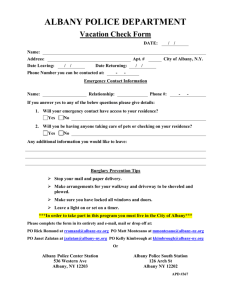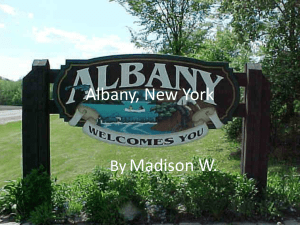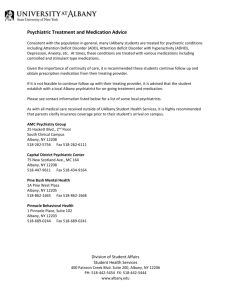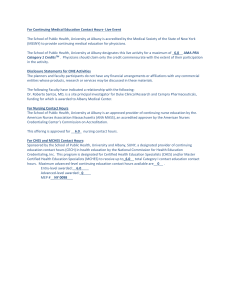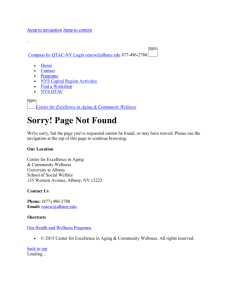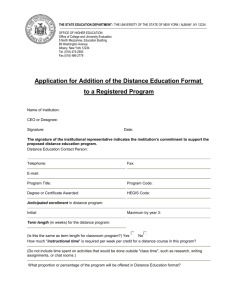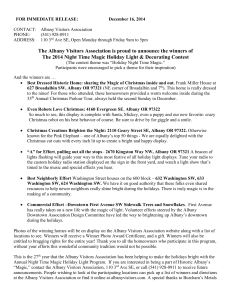Residential Market Potential for Downtown Albany Study Area
advertisement
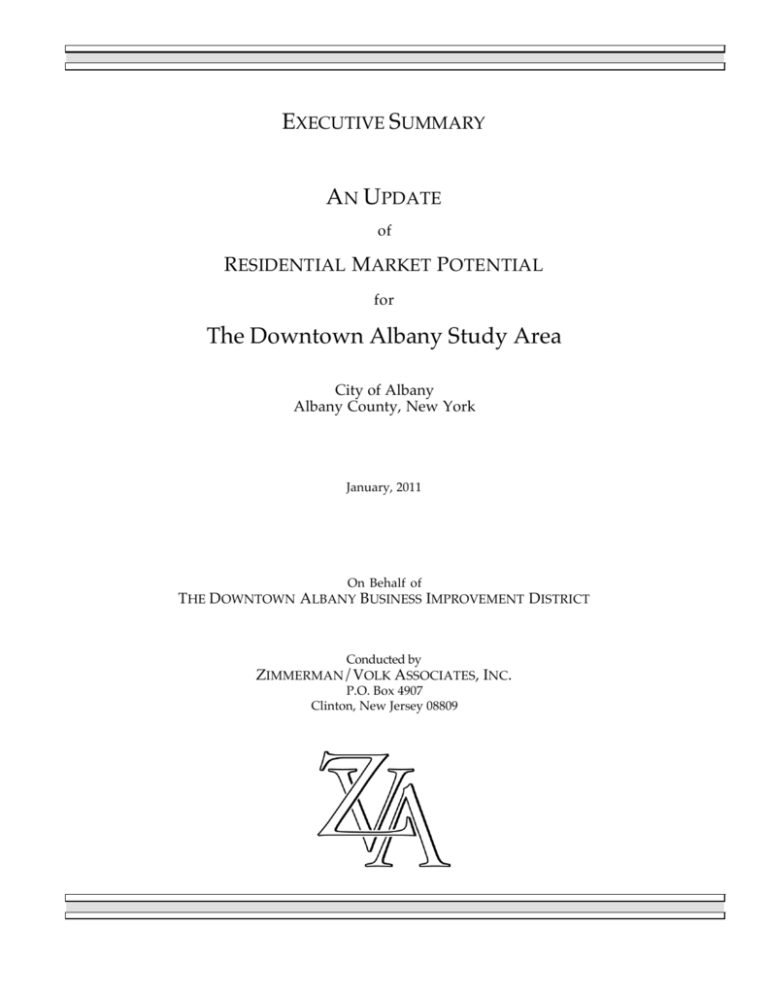
EXECUTIVE SUMMARY AN UPDATE of RESIDENTIAL MARKET POTENTIAL for The Downtown Albany Study Area City of Albany Albany County, New York January, 2011 On Behalf of THE DOWNTOWN ALBANY BUSINESS IMPROVEMENT DISTRICT Conducted by ZIMMERMAN/VOLK ASSOCIATES, INC. P.O. Box 4907 Clinton, New Jersey 08809 ZIMMERMAN/VOLK ASSOCIATES, INC. P.O. Box 4907 Clinton, New Jersey 08809 908 735-6336 www.ZVA.cc • info@ZVA.cc Research & Strategic Analysis EXECUTIVE SUMMARY UPDATE: RESIDENTIAL M ARKET POTENTIAL The Downtown Albany Study Area City of Albany, Albany County, New York January, 2011 The purpose of this study is to re-examine the market potential for newly-introduced market-rate housing units—created both through adaptive re-use of existing non-residential buildings as well as through new construction—that could be leased or sold in the Downtown Albany Study Area. The original Downtown study was published in 2002 and updated in November, 2006. An update is now critical, because, since 2006, the regional economy has been steadily shifting to higher-growth technology-related industries, particularly in the realm of nanotechnology. In addition, downtown residential development has gained considerable traction in the market, with a number of successful new projects that have been introduced since 2006. The boundaries of the Downtown Study Area are the same as those defined for the November, 2006 Update, covering the area bounded by North Ferry Street to the north, the Hudson River to the east, Westerlo Street to the south, and Eagle Street to the west. This area includes the Downtown Business Improvement District, the Downtown Historic District, parts of the Pastures and Mansion Historic Districts, and the easternmost blocks of the Arbor Hill neighborhood. C ONCLUSIONS OF THE ANALYSIS Where are the potential renters and buyers of new housing units in the Downtown Albany Study Area likely to move from? As derived from the updated migration, mobility and target market analysis, the draw area distribution of market potential (those households with the potential to move to the Downtown Albany Study Area) is as follows: E XECUTIVE SUMMARY Page 2 Update: Residential Market Potential The Downtown Albany Study Area City of Albany, Albany County, New York January, 2011 Market Potential by Draw Area THE DOWNTOWN ALBANY STUDY AREA City of Albany, Albany County, New York City of Albany (Local Draw Area): Balance of Albany County (Local Draw Area): Rensselaer, Schenectady, Saratoga, Greene, and Columbia Counties (Regional Draw Area): Kings, New York, Queens, Bronx, and Onondaga Counties (NYC/Syracuse Draw Area): Suffolk, Nassau, Westchester, Ulster, and Dutchess Counties (Suburban NY Draw Area): Balance of US (National Draw Area): 27.0% 16.6% Total: 100.0% 17.0% 7.6% 4.9% 27.0% How many households have the potential to move to the Downtown Study Area if appropriate housing units were to be made available?? Based on the updated target market analysis, approximately 3,750 younger singles and couples, empty nesters and retirees, and compact families represent the annual potential market for new higher=density housing units within the Downtown Albany Study Area. What are their housing preferences in aggregate?? As derived from the tenure and housing preferences of those 3,750 draw area households, the distribution of rental and for-sale multi-family and for-sale single-family attached housing types would be as follows: Potential Market for New Housing Units Higher-Density Housing Units THE DOWNTOWN ALBANY STUDY AREA City of Albany, Albany County, New York HOUSING T YPE NUMBER OF H OUSEHOLDS P ERCENT OF T OTAL Rental Multi-Family (lofts/apartments, leaseholder) 1,980 52.8% For-Sale Multi-Family (lofts/apartments, condo/co-op ownership) 1,160 30.9% For-Sale Single-Family Attached (townhouses/rowhouses, fee-simple ownership) 610 16.3% Total 3,750 100.0% ZIMMERMAN/VOLK ASSOCIATES, INC. E XECUTIVE SUMMARY Page 3 Update: Residential Market Potential The Downtown Albany Study Area City of Albany, Albany County, New York January, 2011 Since the first update was conducted in 2006, there has been a significant increase in the size of the annual potential downtown market—from approximately 2,440 households in 2006 to 3,750 households in 2011—and considerable changes in the type of housing that best matches target household preferences. As a share of the market, multi-family for-rent has risen from 44.2 percent in 2006 to nearly 53 percent in 2011; multi-family for-sale (condominium) units now represent just under 31 percent of the market (down from 32.4 percent in 2006); and single-family attached for-sale (townhouses) comprise 16.3 percent of the market, down from 23.4 percent in 2006. Who is the potential market for new housing in the Study Area? The increasing interest in traditional American neighborhoods—walkable, with a mix of uses and a variety of housing types—is the result of dramatic changes in American households, the growing cost of commuting by private automobile, and the profound impact of the Great Recession—which began in 2007—on both households and home-builders, particularly in exurban locations. The changing composition of American households may have the most lasting influence, however, because of the changing housing preferences of the two largest generations in the history of America: the Baby Boomers (currently estimated at 77 million), born between 1946 and 1964, and the estimated 78 million Millennials, who were born from 1977 to 1996. Both the Boomers and the Millennials share a preference for downtowns and walkable traditional neighborhoods, particularly those served by transit. In contrast to the traditional family (a married couple with children) that comprised the typical post-war American household, Boomers and Millennials are predominantly singles and couples. As updated by the target market analysis and reflecting this national trend, the household groups that comprise the potential market for new Downtown Albany housing units are: • Younger singles and childless couples—74 percent. The continuing challenge in capturing this potential market is to produce new units that are attractive to young people (lofts, not suburban-style apartments), at rents and prices the majority can afford. Since land and construction costs in downtowns are typically higher than ZIMMERMAN/VOLK ASSOCIATES, INC. E XECUTIVE SUMMARY Page 4 Update: Residential Market Potential The Downtown Albany Study Area City of Albany, Albany County, New York January, 2011 in other neighborhoods, this remains difficult to achieve without some form of development incentives.; • Empty nesters and retirees—21 percent. As the national, regional, and local housing markets continue to stabilize, and with the continuing introduction of a wider variety of units in a broad range of rents and prices in the Downtown, older households will again become a larger share of the potential market; and • A range of urban families—5 percent. Nearly all of the traditional and nontraditional family households moving to the Downtown Albany Study Area will be moving from out of town. What are their current housing alternatives? Since the 2006 Update, several small rental properties have been successfully developed within the Downtown Study Area, with rents ranging from approximately $500 per month for the smallest studio to $1,900 per month for the largest two-bedroom apartment. All of the Downtown units are fully occupied, indicating that the market for Downtown rentals has only just begun to be tapped. Outside Downtown Albany, a number of larger rental properties have opened since the 2006 Update, including Albany’s Alexander at Patroon Creek, a very successful 300-unit property with occupancy at 99 percent and rents among the highest in the market area, ranging between $1,195 and $2,275 per month. Elsewhere in the region, rents start at $500 per month for the smallest studios, with the upper ranges of rents at $1,900 per month for a three-bedroom unit. Occupancy rates continue to be very high, ranging between 97 and 100 percent (functional full occupancy). In contrast to 2006, when there were no new condominiums available in Albany, the 24-unit 17 Chapel, is successfully marketing units in Downtown. Base prices range between $299,000 and $779,750 and eight of the units have sold, with four reservations, even though the building is still under construction. Elsewhere in Albany, new for-sale high-density development has consisted of projects of 30 units or less, with base prices starting at just under $300,000 and the most expensive unit priced at $385,000. New condominium and townhouse properties being marketed outside ZIMMERMAN/VOLK ASSOCIATES, INC. E XECUTIVE SUMMARY Page 5 Update: Residential Market Potential The Downtown Albany Study Area City of Albany, Albany County, New York January, 2011 the city are typically larger (30 units or more) and less expensive, with base prices falling between less than $150,000 and just under $290,000. Since 2007, due to the recession and crash of the stock market, sales paces have been modest at nearly all of these properties. What will they pay to live in the Downtown Albany Study Area? Based on the housing preferences and the socio-economic and lifestyle characteristics of the target households in 2011, and the relevant residential context in the Albany market area, the general range of rents and prices for newly-developed market-rate residential units in the Study Area that could currently be sustained by the market is as follows: Rent, Price and Size Range Newly-Created Housing (Adaptive Re-Use and New Construction) THE DOWNTOWN ALBANY STUDY AREA City of Albany, Albany County, New York R ENT /P RICE R ANGE SIZE R ANGE Hard Lofts * $650–$1,450/month 550–1,250 sf $1.16–$1.18 psf Soft Lofts † $950–$1,850/month 750–1,500 sf $1.23–$1.27 psf $1,250–$2,750/month 850–2,000 sf $1.38–$1.47 psf Hard Lofts * $150,000–$235,000 750–1,250 sf $188–$200 psf Soft Lofts † $175,000–$285,000 800–1,350 sf $211–$219 psf Luxury Condominiums $300,000–$600,000 1,100–2,250 sf $267–$273 psf Townhouses/Rowhouses $275,000–$325,000 1,300–1,650 sf $197–$212 psf HOUSING T YPE R ENT /P RICE PER SQ . FT . RENTAL— Luxury Apartments F O R -S ALE — * Unit interiors of “hard lofts” typically have high ceilings and commercial windows and are either minimally finished, limited to architectural elements such as columns and fin walls, or unfinished, with no interior partitions except those for bathrooms. † Unit interiors of “soft lofts” may or may not have high ceilings and are fully finished, with the interiors partitioned into separate rooms. The above rents and prices are in year 2011 dollars, are exclusive of consumer options and upgrades, floor or location premiums, and cover the broad range of rents and prices that could, in normal economic conditions, be sustained by the market in the Downtown Albany Study Area. ZIMMERMAN/VOLK ASSOCIATES, INC. E XECUTIVE SUMMARY Page 6 Update: Residential Market Potential The Downtown Albany Study Area City of Albany, Albany County, New York January, 2011 For the most part (and depending on location), the rents and prices outlined above cannot be achieved by the development of one or two infill units, but require that projects be of sufficient size (at least 20 units) to achieve development efficiency and to support a high-impact marketing campaign. Location will also have a significant impact on rents and prices; projects situated within a short walking distance of high-value amenities, such as restaurants, theaters, shops, or employment, or with views of the Hudson River, will likely command rents and prices at the upper end of values. Those projects in less desirable locations are likely to command rents and prices at the lower end of values. How fast will the units lease or sell? After more than two decades’ experience in scores of cities across the country, and in the context of the target market methodology, Zimmerman/Volk Associates has determined that, over the near term, those households that prefer new construction, rather than previously lived-in units, currently represent between five and 10 percent of the potential rental market, and between two and five percent of the potential for-sale market, given the production of appropriately-positioned new housing. (Until the collapse of the housing market in the fall of 2008, newly-constructed dwelling units comprised approximately 15 percent of all units sold in the nation.) However, short-term absorption projections (market capture) could be lower than the annual number of units described below due to the uncertain timing of a mortgage and housing market recovery. Based on a five to 10 percent capture of the potential market for new rental housing, and a two to five percent capture of the potential market for new for-sale housing units, the Downtown Albany Study area should be able to support up to 134 new market-rate housing units per year over the short term (next three years) and up to 287 units per year in the longer term (four to seven years), as follows: ZIMMERMAN/VOLK ASSOCIATES, INC. E XECUTIVE SUMMARY Page 7 Update: Residential Market Potential The Downtown Albany Study Area City of Albany, Albany County, New York January, 2011 Annual Capture of Market Potential THE DOWNTOWN ALBANY STUDY AREA City of Albany, Albany County, New York HOUSING T YPE NUMBER OF H OUSEHOLDS C APTURE RA T E NUMBER OF NEW UNITS Rental Multi-Family (lofts/apartments, leaseholder) 1,980 5% to 10% 99 to 198 For-Sale Multi-Family (lofts/apartments, condo/co-op ownership) 1,160 2% to 5% 23 to 58 For-Sale Single-Family Attached (townhouses/rowhouses, fee-simple ownership) 610 2% to 5% 12 to 31 Total 3,750 134 to 287 N OTE: Target market capture rates are a unique and highly-refined measure of feasibility. Target market capture rates are not equivalent to—and should not be confused with—penetration rates or traffic conversion rates. The target market capture rate is derived by dividing the annual forecast absorption—in aggregate and by housing type—by the number of households that have the potential to purchase or rent new housing within a specified area in a given year. The penetration rate is derived by dividing the total number of dwelling units planned for a property by the total number of draw area households, sometimes qualified by income. The traffic conversion rate is derived by dividing the total number of buyers or renters by the total number of prospects that have visited a site. Because the prospective market for a location is more precisely defined, target market capture rates are higher than the more grossly-derived penetration rates. However, the resulting higher capture rates are well within the range of prudent feasibility. o ZIMMERMAN/VOLK ASSOCIATES, INC. ZIMMERMAN/VOLK ASSOCIATES, INC. P.O. Box 4907 Clinton, New Jersey 08809 908-735-6336 info@ZVA.cc • www.ZVA.cc Research & Strategic Analysis ASSUMPTIONS AND LIMITATIONS— Every effort has been made to insure the accuracy of the data contained within this analysis. Demographic and economic estimates and projections have been obtained from government agencies at the national, state, and county levels. Market information has been obtained from sources presumed to be reliable, including developers, owners, and/or sales agents. However, this information cannot be warranted by Zimmerman/Volk Associates, Inc. While the methodology employed in this analysis allows for a margin of error in base data, it is assumed that the market data and government estimates and projections are substantially accurate. Absorption scenarios are based upon the assumption that a normal economic environment will prevail in a relatively steady state during development of the subject property. Absorption paces are likely to be slower during recessionary periods and faster during periods of recovery and high growth. Absorption scenarios are also predicated on the assumption that the product recommendations will be implemented generally as outlined in this report and that the developer will apply high-caliber design, construction, marketing, and management techniques to the development of the property. Recommendations are subject to compliance with all applicable regulations. accounting, tax, and legal matters should be substantiated by appropriate counsel. o Relevant ZIMMERMAN/VOLK ASSOCIATES, INC. P.O. Box 4907 Clinton, New Jersey 08809 908 735-6336 www.ZVA.cc • info@ZVA.cc Research & Strategic Analysis RIGHTS AND STUDY O WNERSHIP— Zimmerman/Volk Associates, Inc. retains all rights, title and interest in the methodology and target market descriptions contained within this study. The specific findings of the analysis are the property of the client and can be distributed at the client’s discretion. o ZIMMERMAN/VOLK ASSOCIATES, INC., 2011
